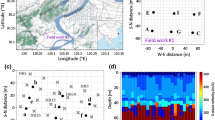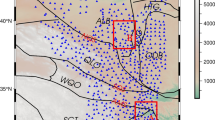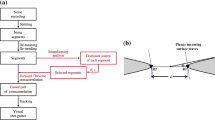Abstract
The retrieval of surface waves from ambient noise is important for delineating the solid earth’s near-surface structures, especially in urban environments. Seismic interferometry (SI) with linear arrays is becoming popular in urban areas with abundant anthropogenic noise. However, retrieving the noise correlation functions (NCFs) is usually challenging for a dense linear array under the demand of short-time recordings and the limited number of stations in urban environments. We comprehensively compare the SI and three-station interferometry, and the results show that the convolution-based three-station interferometry can accurately retrieve the NCFs using short-time recordings for dense linear arrays from traffic-induced noise. A synthetic example demonstrates the superiority of the convolution-based three-station interferometry over the traditional SI and the correlation-based three-station interferometry. Results from two field examples validate the convolution-based three-station interferometry for linear arrays deployed synchronously and asynchronously and confirm its advantage for multi-component data. We conclude that the convolution-based three-station interferometry performs better because it makes better use of linear arrays with short-time recordings and retrieves higher-quality NCFs.




















Similar content being viewed by others
References
Aki K (1957) Space and time spectra of stationary stochastic waves, with special reference to micro-tremors. Bull Earthq Res Inst 35:415–456
Ansaripour M, Rezapour M, Saygin E (2019) Shear wave velocity structure of Iranian plateau: using combination of ambient noise cross-correlations (C1) and correlation of coda of correlations (C3). Geophys J Int 218(3):1919–1938. https://doi.org/10.1093/gji/ggz257
Behm M, Leahy M, Snieder R (2014) Retrieval of local surface wave velocities from traffic noise - an example from the La Barge basin (Wyoming). Geophys Prospect 62:223–243. https://doi.org/10.1111/1365-2478.12080
Boschi L, Weemstra C (2015) Stationary-phase integrals in the cross correlation of ambient noise. Rev Geophys 53:411–451. https://doi.org/10.1002/2014RG000455
Campillo M, Paul A (2003) Long-range correlations in the diffuse seismic coda. Science 299:547–549. https://doi.org/10.1126/science.1078551
Chen Y, Saygin E (2020) Empirical Green’s function retrieval using ambient noise source-receiver Interferometry. J Geophys Res Solid Earth 125(2):e2019JB018261. https://doi.org/10.1029/2019JB018261
Cheng F, Xia J, Xu Y, Xu Z, Pan Y (2015) A new passive seismic method based on seismic interferometry and multichannel analysis of surface waves. J Appl Geophys 117:126–135. https://doi.org/10.1016/j.jappgeo.2015.04.005
Cheng F, Xia J, Luo Y, Xu Z, Wang L, Shen C, Liu R, Pan Y, Mi B, Hu Y (2016) Multi-channel analysis of passive surface waves based on cross-correlations. Geophysics 81(5):EN57–EN66. https://doi.org/10.1190/geo2015-0505.1
Cheng F, Xia J, Xu Z, Hu Y, Mi B (2018) FK-based data selection in high-frequency passive surface wave survey. Surv Geophys 39:661–682. https://doi.org/10.1007/s10712-018-9473-3
Cheng F, Xia J, Xi C (2023) Artifacts in high-frequency passive surface wave dispersion imaging: Toward the linear receiver array. Surv Geophys. https://doi.org/10.1007/s10712-023-09772-1
Curtis A, Halliday D (2010) Source-receiver wave field interferometry. Phys Rev E 81(4):046601. https://doi.org/10.1103/PhysRevE.81.046601
Dai T, Xia J, Ning L, Xi C, Liu Y, Xing H (2021) Deep learning for extracting dispersion curves. Surv Geophys 42:69–95. https://doi.org/10.1007/s10712-020-09615-3
Froment B, Campillo M, Roux P (2011) Reconstructing the Green’s function through iteration of correlations. CR Geosci 343:623–632. https://doi.org/10.1016/j.crte.2011.03.001
Groos JC, Bussat S, Ritter JRR (2012) Performance of different processing schemes in seismic noise cross-correlations: Processing schemes in noise interferometry. Geophys J Int 188:498–512. https://doi.org/10.1111/j.1365-246X.2011.05288.x
Guan B, Xia J (2023) Dataset for Improving the retrieval of high-frequency surface waves using convolution-based three-station interferometry for linear arrays. Mendeley Data. https://doi.org/10.17632/sgbssjpdhf.1
Lawrence JF, Denolle M, Seats KJ, Prieto GA (2013) A numeric evaluation of attenuation from ambient noise correlation functions. J Geophys Res Solid Earth 118:6134–6145. https://doi.org/10.1002/2012JB009513
Lin F, Moschetti MP, Ritzwoller MH (2008) Surface wave tomography of the western United States from ambient seismic noise: Rayleigh and Love wave phase velocity maps. Geophys J Int 173:281–298. https://doi.org/10.1111/j.1365-246X.2008.03720.x
Ling S, Okada H (1993) An extended use of the spatial autocorrelation method for the estimation of geological structure using microtremors. In: Proceedings of the 89th SEGJ Conference
Liu X (2020) Finite-frequency sensitivity kernels for seismic noise interferometry based on differential time measurements. J Geophys Res Solid Earth 125(4):e2019JB018932. https://doi.org/10.1029/2019JB018932
Liu Y, Xia J, Cheng F, Xi C, Shen C, Zhou C (2020) Pseudo-linear-array analysis of passive surface waves based on beamforming. Geophys J Int 221:640–650. https://doi.org/10.1093/gji/ggaa024
Liu Y, Xia J, Xi C, Dai T, Ning L (2021) Improving the retrieval of high-frequency surface waves from ambient noise through multichannel-coherency-weighted stack. Geophys J Int 227:776–785. https://doi.org/10.1093/gji/ggab253
Liu Y, Xia J, Xi C, Zhang H, Guan B, Dai T, Ning L (2022) Enhancing noise sources in stationary-phase zones for accurate phase-velocity estimation of high-frequency surface waves. Geophysics 88(1):L1–L9. https://doi.org/10.1190/geo2021-0696.1
Lobkis OI, Weaver RL (2001) On the emergence of the Green’s function in the correlations of a diffuse field. J Acoust Soc Am 110(6):3011–3017. https://doi.org/10.1121/1.1417528
Louie J (2001) Faster, better: Shear-wave velocity to 100 meters depth from refraction microtremor arrays. Bull Seismol so Am 91:347–364. https://doi.org/10.1785/0120000098
Luo Y, Xia J, Miller RD, Xu Y, Liu J, Liu Q (2009) Rayleigh-wave mode separation by high-resolution linear Radon transform. Geophys J Int 179:254–264. https://doi.org/10.1111/j.1365-246X.2009.04277.x
Luo Y, Xia J, Xu Y, Zeng C (2011) Analysis of group-velocity dispersion of high-frequency Rayleigh waves for near-surface applications. J Appl Geophys 74:157–165. https://doi.org/10.1016/j.jappgeo.2011.04.002
Ma S, Beroza GC (2012) Ambient-field Green’s functions from asynchronous seismic observations. Geophys Res Lett 39:L06301. https://doi.org/10.1029/2011GL050755
Melo G, Malcolm A, Mikesell D, van Wijk K (2013) Using SVD for improved interferometric Green’s function retrieval. Geophys J Int 194:1596–1612. https://doi.org/10.1093/gji/ggt172
Mi B, Xia J, Shen C, Wang L (2018) Dispersion energy analysis of Rayleigh and Love waves in the presence of low-velocity layers in near-surface seismic surveys. Surv Geophys 39:271–288. https://doi.org/10.1007/s10712-017-9440-4
Mi B, Xia J, Bradford JH, Shen C (2020) Estimating Near-surface shear-wave-velocity structures via multichannel analysis of Rayleigh and Love waves: an experiment at the Boise hydrogeophysical research site. Surv Geophys 41:323–341. https://doi.org/10.1007/s10712-019-09582-4
Mi B, Xia J, Tian G, Shi Z, Xing H, Chang X, Xi C, Liu Y, Ning L, Dai T, Pang J, Chen X, Zhou C, Zhang H (2022) Near-surface imaging from traffic-induced surface waves with dense linear arrays: An application in the urban area of Hangzhou, China. Geophys 87(2):B145–B158. https://doi.org/10.1190/geo2021-0184.1
Miller RD, Xia J, Park CB, Ivanov JM (1999) Multichannel analysis of surface waves to map bedrock. Lead Edge 18(12):1392–1396. https://doi.org/10.1190/1.1438226
Moreau L, Stehly L, Boué P, Lu Y, Larose E, Campillo M (2017) Improving ambient noise correlation functions with an SVD-based Wiener filter. Geophys J Int 211:418–426. https://doi.org/10.1093/gji/ggx306
Nakata N, Snieder R, Tsuji T, Larner K, Matsuoka T (2011) Shear wave imaging from traffic noise using seismic interferometry by cross-coherence. Geophysics 76(6):SA97–SA106. https://doi.org/10.1190/geo2010-0188.1
Nakata N (2016) Near-surface S-wave velocities estimated from traffic-induced Love waves using seismic interferometry with double beamforming. Interpretation 4(4):SQ23–SQ31. https://doi.org/10.1190/INT-2016-0013.1
Nayak A, Thurber CH (2020) Using multicomponent ambient seismic noise cross-correlations to identify higher mode Rayleigh waves and improve dispersion measurements. Geophys J Int 222:1590–1605. https://doi.org/10.1093/gji/ggaa270
Ning L, Xia J, Dai T, Liu Y, Zhang H, Xi C (2022) High-frequency surface-wave imaging from traffic-induced noise by selecting In-line Sources. Surv Geophys 43:1873–1899. https://doi.org/10.1007/s10712-022-09723-2
Nishida K, Montagner JP, Kawakatsu H (2009) Global surface wave tomography using seismic hum. Science 326(5949):112–112. https://doi.org/10.1126/science.1176389
Pang J, Cheng F, Shen C, Dai T, Ning L, Zhang K (2019) Automatic passive data selection in time domain for imaging near-surface surface waves. J Appl Geophys 162:108–117. https://doi.org/10.1016/j.jappgeo.2018.12.018
Park CB, Miller RD, Xia J (1998) Imaging dispersion curves of surface waves on multi‐channel record. SEG Expanded Abstracts
Park CB, Miller RD, Ryden N, Xia J, Ivanov J (2005) Combined use of active and passive surface waves. J Environ Eng Geophys 10(3):323–334. https://doi.org/10.2113/JEEG10.3.323
Park CB, Miller RD, Xia J (2007) Multichannel analysis of surface waves (MASW)-active and passive methods. Lead Edge 26:60–64. https://doi.org/10.1190/1.2431832
Park CB, Miller RD (2008) Roadside passive multichannel analysis of surface waves (MASW). J Environ Eng Geophys 13(1):1–11. https://doi.org/10.2113/JEEG13.1.1
Paul A, Campillo M, Margerin L, Larose E, Derode A (2005) Empirical synthetic of time-asymmetrical Green function from the correlation of coda waves. J Geophys Res Solid Earth 110:B08302. https://doi.org/10.1029/2004JB003521
Qiu H, Niu F, Qin L (2021) Denoising surface waves extracted from ambient noise recorded by 1-D linear array using Three-Station interferometry of direct waves. J Geophys Res Solid Earth 126:e2021JB021712. https://doi.org/10.1029/2021JB021712
Quiros DA, Brown LD, Kim D (2016) Seismic interferometry of railroad induced ground motions: body and surface wave imaging. Geophys J Int 205:301–313. https://doi.org/10.1093/gji/ggw033
Rahimi S, Wood CM, Teague DP (2021) Performance of different transformation techniques for MASW data processing considering various site conditions, near-field effects, and modal separation. Surv Geophys 42:1197–1225. https://doi.org/10.1007/s10712-021-09657-1
Rao H, Luo Y, Zhao K, Yang Y (2021) Extracting surface wave dispersion curves from asynchronous seismic stations: method and application. Geophys J Int 226:1148–1158. https://doi.org/10.1093/gji/ggab153
Rost S, Thomas C (2002) Array seismology: Methods and applications. Rev Geophys 40(3):1008. https://doi.org/10.1029/2000RG000100
Roux P, Sabra KG, Kuperman WA, Roux A (2005) Ambient noise cross correlation in free space: theoretical approach. J Acoust Soc Am 117(1):79–84
Schimmel M, Paulssen H (1997) Noise reduction and detection of weak, coherent signals through phase-weighted stacks. Geophys J Int 130:497–505. https://doi.org/10.1111/j.1365-246X.1997.tb05664.x
Schimmel M, Stutzmann E, Gallart J (2011) Using instantaneous phase coherence for signal extraction from ambient noise data at a local to a global scale: ambient noise signal extraction. Geophys J Int 184:494–506. https://doi.org/10.1111/j.1365-246X.2010.04861.x
Seats KJ, Lawrence JF, Prieto GA (2012) Improved ambient noise correlation functions using Welch’s method. Geophys J Int 188:513–523. https://doi.org/10.1111/j.1365-246X.2011.05263.x
Shapiro NM, Campillo M, Stehly L, Ritzwoller MH (2005) High-resolution surface-wave tomography from ambient seismic noise. Science 307:1615–1618. https://doi.org/10.1126/science.1108339
Sheng Y, Denolle MA, Beroza GC (2017) Multicomponent C3 Green’s functions for improved. Bull Seismol Soc Am 107(6):2836–2845. https://doi.org/10.1785/0120170053
Sheng Y, Nakata N, Beroza GC (2018) On the nature of higher-order ambient seismic field correlations. J Geophys Res Solid Earth 123(9):7969–7982. https://doi.org/10.1029/2018JB015937
Snieder R (2004) Extracting the Green’s function from the correlation of coda waves: a derivation based on stationary phase. Phys Rev E 69:046610. https://doi.org/10.1103/PhysRevE.69.046610
Socco LV, Foti S, Boiero D (2010) Surface-wave analysis for building near-surface velocity models—established approaches and new perspectives. Geophysics 75(5):75A83-751A02
Song YY, Castagna JP, Black RA, Knapp RW (1989) Sensitivity of near-surface shear-wave velocity determination from Rayleigh and Love waves. Technical program with biographies. SEG, 59th Annal Meeting, Dallas, Texas, pp 509–512
Song Z, Zeng X, Xie J, Bao F, Zhang G (2021) Sensing shallow structure and traffic noise with fiber-optic internet cables in an urban area. Surv Geophys 42:1401–1423. https://doi.org/10.1007/s10712-021-09678-w
Song Z, Zeng X, Chi B, Bao F, Osotuyi AG (2022) Using the three-station interferometry method to improve urban DAS ambient noise tomography. Front Earth Sci 10:952410. https://doi.org/10.3389/feart.2022.952410
Spica Z, Perton M, Calò M, Legrand D, Cordoba-Montiel F, Iglesias A (2016) 3-D shear wave velocity model of Mexico and South US: bridging seismic networks with ambient noise cross-correlations (C1) and correlation of coda of correlations (C3). Geophys J Int 206(3):1795–1813. https://doi.org/10.1093/gji/ggw240
Spica Z, Perton M, Beroza GC (2017) Lateral heterogeneity imaged by small-aperture ScS retrieval from the ambient seismic field. Geophys Res Lett 44(16):8276–8284. https://doi.org/10.1002/2017GL073230
Stehly L, Campillo M, Froment B, Weaver RL (2008) Reconstructing Green’s function by correlation of the coda of the correlation (C3) of ambient seismic noise. J Geophys Res 113:B11306. https://doi.org/10.1029/2008JB005693
Ventosa S, Schimmel M, Stutzmann E (2017) Extracting surface waves, hum and normal modes: time-scale phase-weighted stack and beyond. Geophys J Int 211:30–44. https://doi.org/10.1093/gji/ggx284
Wang Y, Lin F, Ward KM (2019) Ambient noise tomography across the Cascadia subduction zone using dense linear seismic arrays and double beamforming. Geophys J Int 217:1668–1680. https://doi.org/10.1093/gji/ggz109
Wapenaar K, Fokkema J (2006) Green’s function representations for seismic interferometry. Geophysics 71(4):SI33–SI46. https://doi.org/10.1190/1.2213955
Wapenaar K, van der Neut J (2010) A representation for Green’s function retrieval by multidimensional deconvolution. J Acoust Soc Am 128(6):EL366–EL371. https://doi.org/10.1121/1.3509797
Weaver RL, Lobkis OI (2004) Diffuse fields in open systems and the emergence of the Green’s function. J Acoust Sco Am 116(5):2371–2734. https://doi.org/10.1121/1.4809391
Xi C, Mi B, Dai T, Liu Y, Ning L (2020) Spurious signals attenuation using SVD-based Wiener filter for near-surface ambient noise surface wave imaging. J Appl Geophys 183:104220. https://doi.org/10.1016/j.jappgeo.2020.104220
Xia J, Miller RD, Park CB (1999) Estimation of near-surface shear-wave velocity by inversion of Rayleigh waves. Geophysics 64(3):691–700. https://doi.org/10.1190/1.1444578
Xia J, Miller RD, Park CB, Tian G (2003) Inversion of high frequency surface waves with fundamental and higher modes. J Appl Geophys 52(1):45–57. https://doi.org/10.1016/S0926-9851(02)00239-2
Xia J, Xu Y, Miller RD (2007) Generating an image of dispersive energy by frequency decomposition and slant stacking. Pure Appl Geophys 164:941–956. https://doi.org/10.1007/s00024-007-0204-9
Xia J, Miller RD, Xu Y, Luo Y, Chen C, Liu J, Ivanov J, Zeng C (2009) High-frequency Rayleigh-wave method. J Earth Sci 20(3):563–579. https://doi.org/10.1007/s12583-009-0047-7
Xia J, Xu Y, Luo Y, Miller RD, Cakir R, Zeng C (2012) Advantages of using multichannel analysis of love waves (MALW) to estimate near-surface shear-wave velocity. Surv Geophys 33:841–860. https://doi.org/10.1007/s10712-012-9174-2
Xie J, Yang Y, Luo Y (2020) Improving cross-correlations of ambient noise using an rms-ratio selection stacking method. Geophys J Int 222:989–1002. https://doi.org/10.1093/gji/ggaa232
Xu Y, Luo Y (2015) Methods of ambient noise-based seismology and their applications. Chin J Geophys 58(8):2618–2636. https://doi.org/10.6038/cjg20150803
Yang Y, Ritzwoller MH, Levshin AL, Shapiro NM (2007) Ambient noise Rayleigh wave tomography across Europe. Geophys J Int 168:259–274. https://doi.org/10.1111/j.1365-246X.2006.03203.x
Yao H, van der Hilst RD (2009) Analysis of ambient noise energy distribution and phase velocity bias in ambient noise tomography, with application to SE Tibet. Geophys J Int 179(2):1113–1132. https://doi.org/10.1111/j.1365-246X.2009.04329.x
Yao H, van der Hilst RD, de Hoop MV (2006) Surface-wave array tomography in SE Tibet from ambient seismic noise and two-station analysis – I. Phase velocity maps. Geophys J Int 166:732–744. https://doi.org/10.1111/j.1365-246X.2006.03028.x
Zhang H, Mi B, Liu Y, Xi C, Kouadio KL (2021a) A pitfall of applying one-bit normalization in passive surface-wave imaging from ultra-short roadside noise. J Appl Geophys 187:104285. https://doi.org/10.1016/j.jappgeo.2021.104285
Zhang H, Mi B, Xi C, Liu Y, Guan B, Ning L (2022) Extraction of surface-wave phase velocities from ambient noise in the presence of local noise sources based on matched-field processing. J Appl Geophys 204:104755. https://doi.org/10.1016/j.jappgeo.2022.104755
Zhang J, Yang X (2013) Extracting surface wave attenuation from seismic noise using correlation of the coda of correlation. J Geophys Res Solid Earth 118:2191–2205. https://doi.org/10.1002/jgrb.50186
Zhang S, Feng L, Ritzwoller MH (2020) Three-station interferometry and tomography: coda versus direct waves. Geophys J Int 221:521–541. https://doi.org/10.1093/gji/ggaa046
Zhang S, Wang H, Wu M, Ritzwoller MH (2021b) Isotropic and azimuthally anisotropic Rayleigh wave dispersion across the Juan de Fuca and Gorda plates and U.S. Cascadia from earthquake data and ambient noise two- and three-station interferometry. Geophys J Int 226:862–883. https://doi.org/10.1093/gji/ggab142
Zhang Y, Li YE, Zhang H, Ku T (2019) Near-surface site investigation by seismic interferometry using urban traffic noise in Singapore. Geophysics 84:B169–B180. https://doi.org/10.1190/geo2017-0798.1
Zhou C, Xi C, Pang J, Liu Y (2018) Ambient noise data selection based on the asymmetry of cross-correlation functions for near surface applications. J Appl Geophys 159:803–813. https://doi.org/10.1016/j.jappgeo.2018.09.033
Zhou C, Xia J, Pang J, Cheng F, Chen X, Xi C, Zhang H, Liu Y, Ning L, Dai T, Min B, Zhou C (2021) Near-surface geothermal reservoir imaging based on the customized dense seismic network. Surv Geophys 42:673–697. https://doi.org/10.1007/s10712-021-09642-8
Zhou C, Xia J, Cheng F, Pang J, Chen X, Xing H, Chang X (2022) Passive surface-wave waveform inversion for source-velocity joint imaging. Surv Geophys 43:853–881. https://doi.org/10.1007/s10712-022-09691-7
Acknowledgements
The authors thank the Editor in Chief Michael J. Rycroft and three anonymous reviewers for their constructive comments and suggestions, which significantly improved the manuscript. This study is supported by the National Natural Science Foundation of China under grant No.41830103. Field datasets used in this study have been archived in Mendeley Data (Guan and Xia 2023).
Funding
This study was funded by the National Natural Science Foundation of China (Grant No. 41830103).
Author information
Authors and Affiliations
Corresponding author
Ethics declarations
Conflict of interest
Bo Guan declares that he has no conflict of interest. Jianghai Xia has received a research grant from the National Natural Science Foundation of China (Grant No. 41830103). Jianghai Xia declares that he has no conflict of interest. Ya Liu declares that he has no conflict of interest. Chaoqiang Xi declares that he has no conflict of interest. Binbin Mi declares that he has no conflict of interest. Hao Zhang declares that he has no conflict of interest. Jingyin Pang declares that he has no conflict of interest. Baiyang You declares that he has no conflict of interest.
Ethical approval
This article does not contain any studies with human participants or animals performed by any authors.
Additional information
Publisher's Note
Springer Nature remains neutral with regard to jurisdictional claims in published maps and institutional affiliations.
Rights and permissions
Springer Nature or its licensor (e.g. a society or other partner) holds exclusive rights to this article under a publishing agreement with the author(s) or other rightsholder(s); author self-archiving of the accepted manuscript version of this article is solely governed by the terms of such publishing agreement and applicable law.
About this article
Cite this article
Guan, B., Xia, J., Liu, Y. et al. Improving the Retrieval of High-Frequency Surface Waves Using Convolution-Based Three-Station Interferometry for Dense Linear Arrays. Surv Geophys 45, 459–487 (2024). https://doi.org/10.1007/s10712-023-09816-6
Received:
Accepted:
Published:
Issue Date:
DOI: https://doi.org/10.1007/s10712-023-09816-6




